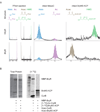Polyketide β-branching in bryostatin biosynthesis: identification of surrogate acetyl-ACP donors for BryR, an HMG-ACP synthase
- PMID: 21035732
- PMCID: PMC2990979
- DOI: 10.1016/j.chembiol.2010.08.008
Polyketide β-branching in bryostatin biosynthesis: identification of surrogate acetyl-ACP donors for BryR, an HMG-ACP synthase
Abstract
In vitro analysis of natural product biosynthetic gene products isolated from unculturable symbiotic bacteria is necessary to probe the functionalities of these enzymes. Herein, we report the biochemical characterization of BryR, the 3-hydroxy-3-methylglutaryl (HMG)-CoA synthase (HMGS) homolog implicated in β-branching at C13 and C21 of the core ring system from the bryostatin metabolic pathway (Bry). We confirmed the activity of BryR using two complementary methods, radio-SDS PAGE, and Fourier transform ion cyclotron resonance-mass spectrometry (FTICR-MS). The activity of BryR depended on pairing of the native acetoacetyl-BryM3 acceptor acyl carrier protein (ACP) with an appropriate donor acetyl-ACP from a heterologous HMGS cassette. Additionally, the ability of BryR to discriminate between various ACPs was assessed using a surface plasmon resonance (SPR)-based protein-protein binding assay. Our data suggest that specificity for a protein-bound acyl group is a distinguishing feature between HMGS homologs found in PKS or PKS/NRPS biosynthetic pathways and those of primary metabolism. These findings reveal an important example of molecular recognition between protein components that are essential for biosynthetic fidelity in natural product assembly and modification.
Copyright © 2010 Elsevier Ltd. All rights reserved.
Figures




Comment in
-
Using surrogates to bypass missing catalytic components.Chem Biol. 2010 Oct 29;17(10):1045-6. doi: 10.1016/j.chembiol.2010.10.001. Chem Biol. 2010. PMID: 21035724 Free PMC article.
Similar articles
-
Anatomy of the β-branching enzyme of polyketide biosynthesis and its interaction with an acyl-ACP substrate.Proc Natl Acad Sci U S A. 2016 Sep 13;113(37):10316-21. doi: 10.1073/pnas.1607210113. Epub 2016 Aug 29. Proc Natl Acad Sci U S A. 2016. PMID: 27573844 Free PMC article.
-
A conserved motif flags acyl carrier proteins for β-branching in polyketide synthesis.Nat Chem Biol. 2013 Nov;9(11):685-692. doi: 10.1038/nchembio.1342. Epub 2013 Sep 22. Nat Chem Biol. 2013. PMID: 24056399 Free PMC article.
-
Chemoenzymatic Dissection of Polyketide β-Branching in the Bryostatin Pathway.Methods Enzymol. 2018;604:207-236. doi: 10.1016/bs.mie.2018.01.034. Epub 2018 Apr 9. Methods Enzymol. 2018. PMID: 29779653 Free PMC article.
-
Past achievements, current status and future perspectives of studies on 3-hydroxy-3-methylglutaryl-CoA synthase (HMGS) in the mevalonate (MVA) pathway.Plant Cell Rep. 2014 Jul;33(7):1005-22. doi: 10.1007/s00299-014-1592-9. Epub 2014 Mar 30. Plant Cell Rep. 2014. PMID: 24682521 Review.
-
Probing the structure and function of acyl carrier proteins to unlock the strategic redesign of type II polyketide biosynthetic pathways.J Biol Chem. 2021 Jan-Jun;296:100328. doi: 10.1016/j.jbc.2021.100328. Epub 2021 Jan 23. J Biol Chem. 2021. PMID: 33493513 Free PMC article. Review.
Cited by
-
Heterologous Production of the C33-C45 Polyketide Fragment of Anticancer Apratoxins in a Cyanobacterial Host.Org Lett. 2023 Apr 7;25(13):2238-2242. doi: 10.1021/acs.orglett.3c00462. Epub 2023 Mar 24. Org Lett. 2023. PMID: 36961224 Free PMC article.
-
Insights from the sea: structural biology of marine polyketide synthases.Nat Prod Rep. 2012 Oct;29(10):1038-49. doi: 10.1039/c2np20016c. Epub 2012 Apr 13. Nat Prod Rep. 2012. PMID: 22498975 Free PMC article. Review.
-
Characterization of the lnmKLM genes unveiling key intermediates for β-alkylation in leinamycin biosynthesis.Org Lett. 2011 Feb 4;13(3):498-501. doi: 10.1021/ol102838y. Epub 2010 Dec 30. Org Lett. 2011. PMID: 21192727 Free PMC article.
-
Integrated Metabolomic-Genomic Workflows Accelerate Microbial Natural Product Discovery.Anal Chem. 2022 Sep 6;94(35):11959-11966. doi: 10.1021/acs.analchem.2c02245. Epub 2022 Aug 22. Anal Chem. 2022. PMID: 35994737 Free PMC article. Review.
-
Predominately Uncultured Microbes as Sources of Bioactive Agents.Front Microbiol. 2016 Nov 18;7:1832. doi: 10.3389/fmicb.2016.01832. eCollection 2016. Front Microbiol. 2016. PMID: 27917159 Free PMC article. Review.
References
-
- Sudek S, Lopanik NB, Waggoner LE, Hildebrand M, Anderson C, Liu H, Patel A, Sherman DH, Haygood MG. Identification of the putative bryostatin polyketide synthase gene cluster from "Candidatus Endobugula sertula", the uncultivated microbial symbiont of the marine bryozoan Bugula neritina. J. Nat. Prod. 2007;70:67–74. - PubMed
-
- Nelson TJ, Alkon DL. Neuroprotective versus tumorigenic protein kinase C activators. Trends in Biochem. Sci. 2009;34:136–145. - PubMed
-
- Banarjee S, Wang Z, Mohammad M, Sarkar FH, Mohammad RM. Efficacy of selected natural products as therapeutic agents against cancer. J. Nat. Prod. 2008;71:492–496. - PubMed
Publication types
MeSH terms
Substances
Grants and funding
LinkOut - more resources
Full Text Sources
Molecular Biology Databases
Miscellaneous

